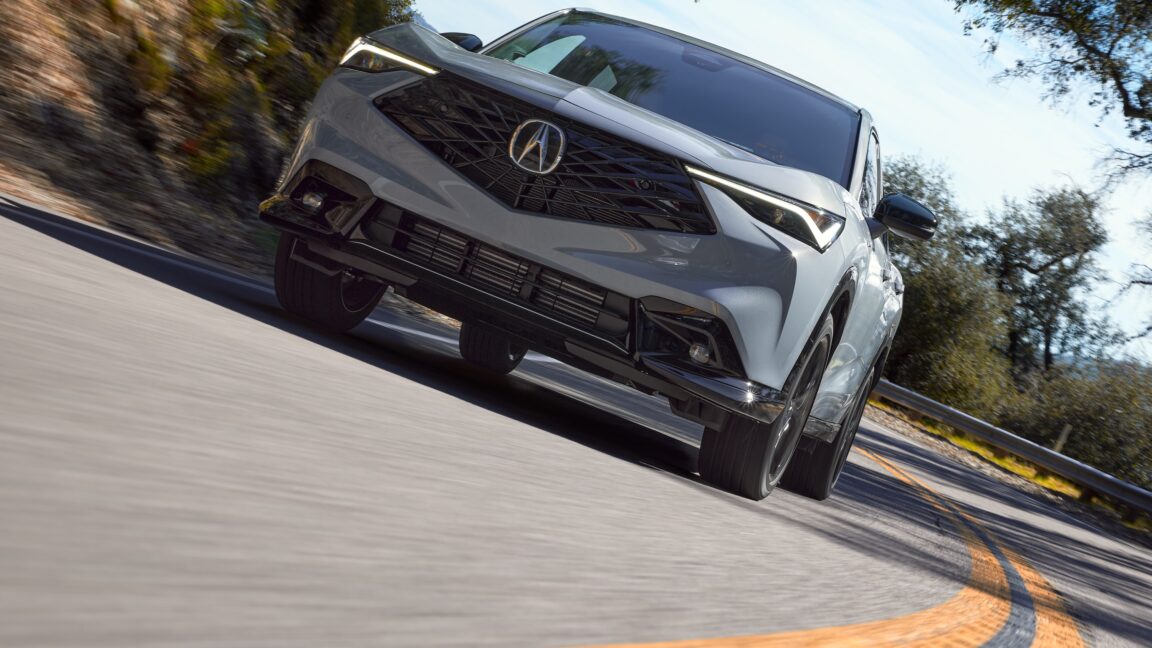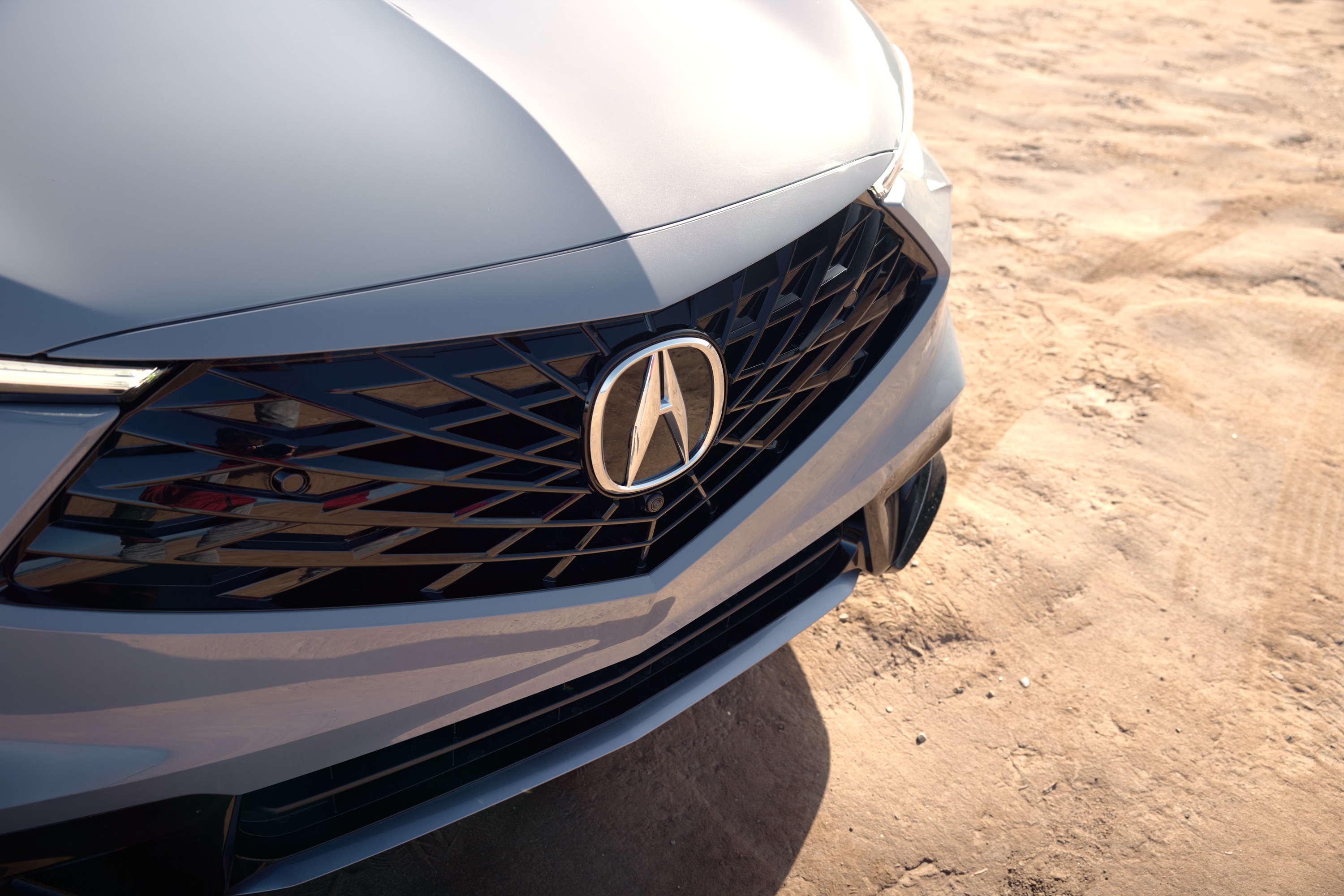
Credit: Acura
As you might imagine, a steady stream of cars to review comes and goes from my parking spot. Some weeks, they stand out, like the bright green Aston Martin, the murdered-out Bentley, or the VW ID. Buzz you can read about soon; these cars usually spark conversations with neighbors, particularly those who don't know why there's a different vehicle in that spot each week.
At other times, the vehicles are more anonymous, and I'm not sure this ADX sparked any community discussions. Compact crossovers are a popular breed and blend into the background. Particularly when they're painted an unobtrusive shade.
Which is not to say the ADX is not handsome; the Urban Gray Pearl paint looked good even in the near-constant rain (which explains the Acura-supplied images rather than my own) that coincided with our time with the tester. And from the driver's seat, the view down the hood, along those creases, is a lot more interesting than most comparable crossovers, considering the ADX's $35,000 starting price.
It's built in Mexico alongside the Honda HR-V, and shares a platform with the Acura Integra and Honda Civic. Like the HR-V, there's no hybrid option, just a 1.5 L turbocharged four-cylinder engine with 190 hp (142 kW) and 179 lb-ft (243 Nm). There's also only one choice of transmission—a continuously variable transmission.
This has preprogrammed "shift points" that simulate the gears of a more conventional transmission. Acura says it has been programmed for performance, and you can use the steering wheel's paddles to change up or down a virtual gear. The turbocharged engine starts making all its torque from 1,700 rpm, but if you're in a hurry, you'll first hear the revs rise out of proportion to the initial increase in speed, and full power doesn't arrive until 6,000 rpm, with the redline 500 rpm further north. It's not the best-sounding engine in the world when it's revved up, either.
As standard, the ADX is just front-wheel drive, but all-wheel drive is available for an additional $2,000. This can send up to half the engine's available torque to the rear wheels, but expect it to be front-biased in day-to-day driving conditions.

I love the view from the driver's seat down the spine of the hood.
Credit: Acura
Fuel efficiency is not remarkable, but here it's about average for the class. With all-wheel drive, as tested, the EPA estimates 27 mpg combined (8.7 L/100 km); I actually returned a slightly better 28 mpg (8.4 L/100 km) across the week.
It's also going to be slower than most comparable crossovers: at 8.7 seconds, its 0–60 mph (0–97 km/h) time is glacial compared to something like BMW's X1, but even a non-turbocharged Mazda CX-30 will outdo the Acura.
Despite that, I found the ADX a rather pleasant car to drive. It corners without much roll despite being loftier than a sedan, and bad road imperfections are handled by the ADX's suspension without bothering the occupants much. I should commend the steering, which is relatively quick with just 2.4 turns lock-to-lock and is well-weighted, even in Sport mode. In fact, this is a crossover that might well prompt me to take the longer way home, although I wouldn't put the handling ahead of the aforementioned CX-30, which remains the pick of the class in terms of driver engagement.
If you know where to look, you'll recognize bits from the Honda parts bin in the ADX's interior—the digital main instrument display seems pretty familiar. The good news is that there are plenty of physical controls, with dials and buttons for the temperature and fans. The big gear lever feels a little incongruous as most other Honda and Acura models have adopted three buttons for the transmission, but I think that's consistent with its factory sibling, the Honda HR-V.
The ADX is relatively well-appointed, particularly in the $44,000 A-Spec with Advance trim as tested. However, even the entry-level ADX comes with a powered tailgate, heated front seats, wireless Apple CarPlay and Android Auto, and wireless charging as well as USB-C ports. You also get a full complement of Honda and Acura's advanced driver assistance systems and safety tech, although, as usual, the collision warnings are a little too eager, and you can expect a few false positives a week.
But given the recent news about Acura killing off connected car services for cars that are only slightly older, I'm not sure I'd get too dependent on any smartphone integration or remote apps.
The market for a compact crossover at or around $40,000 is one of the most crowded, with plenty of options for buyers to choose from. A German alternative might be faster, but not necessarily better to drive, and you'll probably have to spend more to get an equivalent equipment level. My pick probably remains the CX-30 because it drives so well, and that's important to me, but this Acura is a decent middle ground if you're looking for a more premium badge while still balancing the budget and spirit.

-
 C114 Communication Network
C114 Communication Network -
 Communication Home
Communication Home


